Apollo Arrow
Disclosure: We may receive commissions when you click our links and make purchases. Read our full affiliate disclosure here.
- About to bite the bullet and go down the route of UAD?
- Confused about which UAD interface is right for you?
- We help you make an informed buying decision

[17th August 2020] Update: UAD Apollo Solo Announced!
UAD recently announced that the UAD Arrow will be superseded by the brand new UAD Apollo Solo.
Not much has changed besides a brand new color, and the choice between a USB3 or Thunderbolt device. It is being considered as a rebrand of the Arrow, and hardware/features stay largely the same:
- Two XLR-1/4" combo inputs with Unison microphone preamps
- A Hi-Z instrument input in front
- Two line outputs
- Headphone outputs
- 192 kHz/24-bit resolution
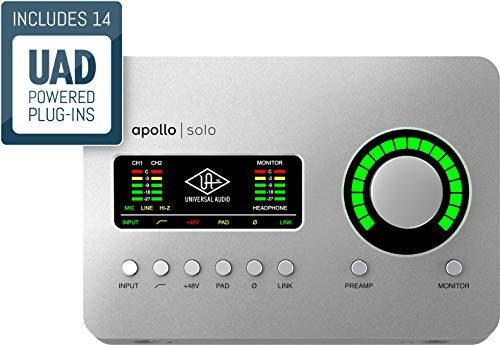
Universal Audio has set a lot of standards over the years, and their Arrow interface continues this tradition. It's easily one of the best Thunderbolt audio interfaces out there, and an affordable way to get your hands on the classic UAD sound.
Already well known for their Apollo series, UAD recently introduced the Arrow line which is similar, but different enough to warrant comparison.
Apollo Twin vs Arrow: Who Wins?
For me, if I have to choose a UAD interface, it's a tie between the Arrow and the Apollo Twin X. The spectacular converters and other features of the Twin X give you the best quality and great usability for the cost. Whilst the Arrow is more affordable – its quality processors, converters and compatibility make for fantastic value.
But it really comes down to my particular needs, and of course, everyone is different.
If cost is your main concern then we'd suggest looking at the Arrow, however if you can afford a little more and are really focussing on audio quality then the Twin X is for you.
Model
UAD Apollo Twin MKII Quad
Universal Audio Apollo Twin USB
I/O 2x4 + 8 Optical Inputs
I/O 2x6 + 8 Optical Inputs

I/O 2x4 + 8 Optical Inputs
I/O 2x6 + 8 Optical Inputs
Budget Pick

I/O 2x4 + 8 Optical Inputs
I/O 2x6 + 8 Optical Inputs

I/O 2x4 + 8 Optical Inputs
I/O 2x6 + 8 Optical Inputs
Premium Pick

Model
UAD Apollo Twin MKII Quad
I/O 2x4 + 8 Optical Inputs
I/O 2x6 + 8 Optical Inputs

Model
Universal Audio Apollo Twin USB
I/O 2x4 + 8 Optical Inputs
I/O 2x6 + 8 Optical Inputs
Why Choose UAD?
Universal Audio's studio rack audio interfaces are considered top of the range. Now they have started to include this technology in their desktop interface range making them incredible in terms of quality, functionality and portability.
All the devices featured in this article are excellent units. Universal Audio have provided ingenuity and great design to bring you high sample rate, fantastic A/D converters and iconic preamp emulation all with UAD's 'Near Zero Latency' technology.
Let's Compare
In the market now are the Universal Audio Apollo Twin series and the new Universal Audio Arrow. These products are similar in size and almost similar in functionality. The Apollo Twin series currently has three main models to the Arrow's single model.
The Apollo Twin series consists of
- Apollo Twin USB
- Apollo Twin MKII – (Duo and Quad)
- Apollo Twin X – (Duo and Quad)
All of these devices can record up to 192kHz at 24 bits per sample. Although they are designed to be used with the Universal Audio software, they are compatible with all major DAWs, including
They also all have the following
- Phantom power
- Hi-Z input
- Headphones out
- I/O metering
- HPF (High pass filter)
- Ø reverse (Phase' reverse)
- 20dB Pad (For mic preamps)
- Stereo link for inputs
- Internal UAD DSP acceleration
UAD DSP Explained
Universal Audio are well known for their DSP technology which allows users to run special high end analog emulation plugins with near zero latency. These plugins are exclusive to UAD and can't be used without a UAD device!
This also allows you to add extra processing to the input before the sound hits your DAW, with special guitar sims, compressors and EQs based off vintage circuitry.
Universal Audio devices come with a large collection of these plugins so you can work with them straight out of the box. Just plug the interface in, load up the software, and jam away.
Breaking It All Down
1. UAD Apollo Twin USB Review
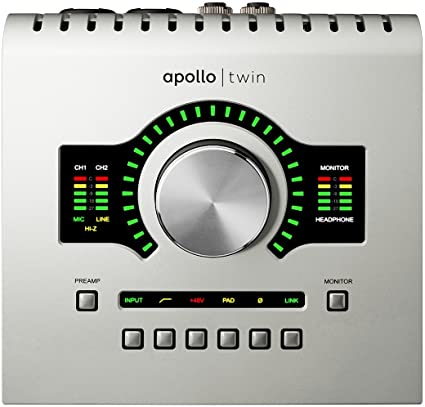
The first in the Apollo Twin Series is the Apollo Twin USB. As the name suggests, it's a USB 3 device. It's also the only USB device in this article as it was released in 2014, however it's still a fantastic unit.
USB 3 delivers up to 5Gb/s which is more than enough for multitrack recording and as the plugin processing is done onboard with its two (Duo) SHARC DSP processors, you can still get 'near zero' latency when using the 'UAD' plugins.
As mentioned, there are two mic / line combo inputs and a Hi-Z input for direct guitar or bass. It has a -20dB pad, Ø reverse and can link stereo inputs. This device has fantastic quality A/D converters and also features extra outputs for monitoring. The levels for these can be adjusted either on the interface itself or in the software 'Console'.

You will also get the 'Realtime Analog Classic Bundle' with legendary compressors like the Teletronix LA-2A and EQs like the Pultec EQP-1A, stunning guitar and bass amp emulations from Softube, as well as UA's landmark 610-B Tube Preamp and EQ plug-in.
You can also add eight additional inputs using the devices 'ADAT Optical' in.
This unit has six output channels of digital-to-analog conversion via digitally controlled stereo monitor outputs, stereo headphone outputs and line outputs 3 & 4.
Unfortunately, the Apollo Twin USB is only compatible with Windows due to the type of USB 3 card.
2. UAD Apollo Twin MKII Duo/Quad Review
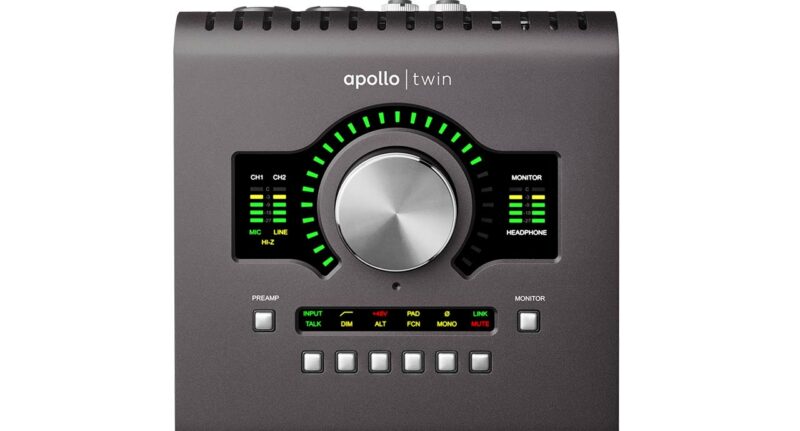
The Apollo Twin MKII is very similar to the Twin USB model. You get the Realtime Analog Classic Bundle, eight additional inputs using the 'ADAT Optical' expansion, six output channels, stereo headphone outputs and line outputs 3 & 4.
But there are also a few differences. The DSP in this unit is the 'UAD2' DSP and you get 2 of them (hence 'Duo').
This unit is also available with a 4x Core DSP option which is the "Quad" version. This lets you have a lot more plugins running at the same time and more processing means you can utilize more CPU taxing plugins.
This model also includes a 'talkback' function, giving you a built-in microphone for communication and recording through your monitors in your live room. This is something most desktop interfaces lack and will be invaluable for those working with other musicians!
The included software is a seriously impressive, fully-featured DAW. It's called 'LUNA' and it is Universal Audio's next version of 'Console'. UAD describe LUNA rather ambitiously as "the fastest recording environment for music production, editing, and mixing".

But the main difference between the Twin USB and this unit is Thunderbolt 2. So it's compatible with Mac OSX, but also with Windows. However, Thunderbolt 2 is still rare on Windows machines.
This Thunderbolt upgrade also has another fantastic feature that allows you to add additional inputs by daisy-chaining other Apollo devices!
When more I/O or DSPs are needed, up to four Apollo interfaces can be chained together via Thunderbolt in a multiple-unit configuration. This allows for future flexibility if you plan on expanding your studio later on. The MKII also has upgraded A/D converters for efficient and precise audio capture.
The MKII is basically the Mac version of the USB but with the upgrade of the extra DSPs, the talkback function and the multi unit chain via Thunderbolt 2.
3. UAD Apollo Twin X Duo/Quad Review

The Apollo Twin X Duo/Quad is very similar to the MKII and USB. Once again, you get the Realtime Analog Classic Bundle with all the same compressors and amp models as before.

You can add the eight additional inputs using the device's 'ADAT Optical' in and you also have the six output channels of digital-to-analog conversion via digitally-controlled stereo monitor outputs, stereo headphone outputs and line outputs 3 & 4. It also has the option for Duo or Quad DSPs and runs alongside the LUNA software.
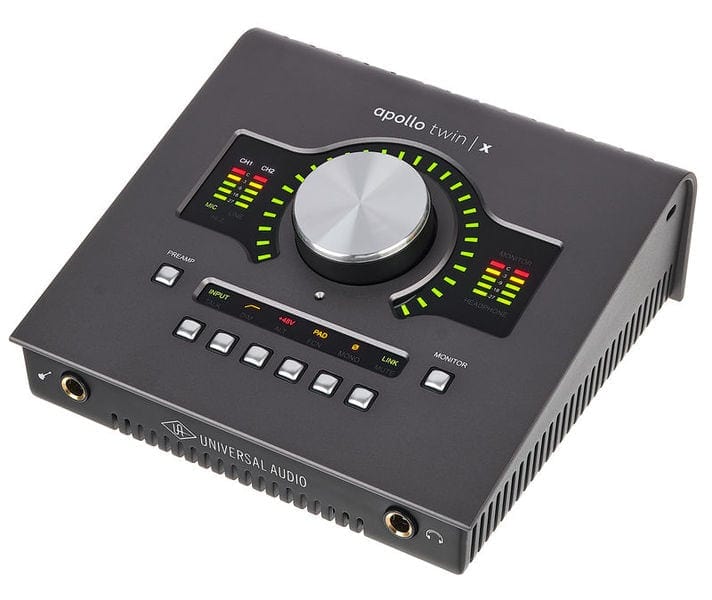
The functionality of the Apollo Twin X is identical to the Apollo Twin MKII expect for the stereo monitor outputs which are independently addressable, and all the outputs on the X are 'DC-coupled'. This means super low frequencies will not hinder your listening source. This may not be all that noticeable but some will appreciate the difference!
Universal Audio have increased the efficiency and accuracy of the A/D converters and have stepped up the connectivity to Thunderbolt 3. This means faster transfer speeds and compatibility with Mac OSX and Windows.
I recommend checking the connections on your computer to make sure you can get the fastest interface possible!

4. UAD Arrow Review (Now Known As "Solo")
The Arrow is a great interface. It has the processing power of the Twin USB and connectivity speeds of the Twin X.
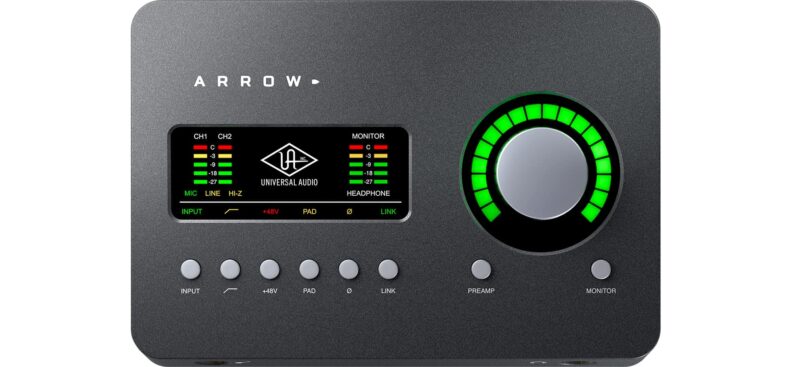
It's relatively new and is a simplified version of all of these devices, but doesn't compromise on sound quality.
This is handy, as not everyone will require talkback or extra monitor outputs. This device is designed to give you the same power without the flashy features and makes high-quality UAD interfaces more affordable.
It features the same preamp functions like the 2x mic preamp/line in combos, phantom power, Hi-Z input, headphone outputs, I/O metering, high pass filter, Ø reverse, -20dB pad, stereo link-able inputs and internal DSP.
The Arrow runs the onboard UAD-2 DSP Accelerator with SHARC SOLO core processing with four output channels of digital/analog conversion.
Included are the same high-class preamps as the Twin X and the same compatibility with the LUNA software. You can also add four additional Universal Audio interfaces and 6x UAD 2 devices if you wish to expand. The headphone bus is separated from the main outputs.
The Arrow is also compatible with both Mac OSX and Windows.
The other great thing about this unit is that it doesn't require additional power. It sources power from the Thunderbolt 3 connection which is a plus for portability.

So, Which Interface Is Best For Your Individual Needs?
All these devices are all pretty evenly matched in quality. Even the lower spec models are very, very nice, so the decision will come down to price and functions/features.
The Apollo Twin X
- The Apollo Twin X is the leader in features and quality. You have the best preamps Universal Audio offer, and paired with the emulations you can have almost whichever preamp sound you want.
- If you have a control room and a keen ear, the Twin X is for you. If you like to use amp sims, compressors and preamp emulators while tracking, you might even want to consider the quad version for extra processing power.
The Apollo Twin MKII
- The Apollo Twin MKII would be the best choice for someone on a Mac.
- The converters may not be the same but they are still great quality. You'll still get the same essential features and the same processing power.
- The Apollo Twin USB has less functionality with no talkback function and the duo processor may not be the latest but it is still good. You can get these for the same cost as the Apollo Twin X Duo.
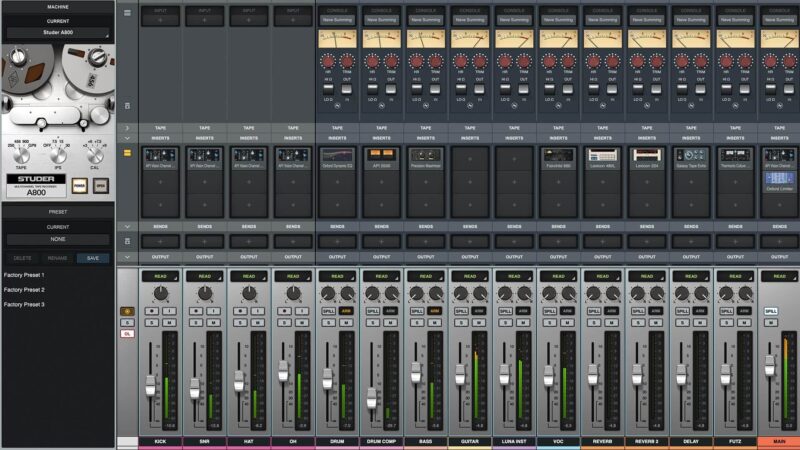
UAD Arrow
- The Arrow is the best device here for someone who just needs a good quality interface for their home studio or mobile rig.
- It features the same connectivity as the Twin X and the same processors. The A/D Converters differ but they are still great, and if you don't need additional monitors and talkback mic, then this is the unit for you.
The Apollo Twin USB
- The Apollo Twin USB has less functionality regarding the talkback functions.
- Getting the Twin X would not only give you better A/D Conversion but also talkback capabilities and compatibility with Mac and Windows.
- It will also allow you to daisy-chain other Apollo devices to increase your input count.
Final Thoughts
All these devices show a slight but significant progression in Universal Audio's technology over the last six years. The limited compatibility in the Apollo Twin USB, unfortunately, renders it a bit redundant these days, however, it is still great in its own right.
It's almost a similar case with the Apollo Twin MKII as most Windows machines won't have Thunderbolt 2. But if you only use a Mac for your production work then that's not an issue.
The Arrow and the Apollo Twin X definitely maximize the technology available, accurately representing the needs of different producers and engineers while also reflecting that in their cost.
Model
UAD Apollo Twin MKII Quad
Universal Audio Apollo Twin USB
I/O 2x4 + 8 Optical Inputs
I/O 2x6 + 8 Optical Inputs

I/O 2x4 + 8 Optical Inputs
I/O 2x6 + 8 Optical Inputs
Budget Pick

I/O 2x4 + 8 Optical Inputs
I/O 2x6 + 8 Optical Inputs

I/O 2x4 + 8 Optical Inputs
I/O 2x6 + 8 Optical Inputs
Premium Pick

Model
UAD Apollo Twin MKII Quad
I/O 2x4 + 8 Optical Inputs
I/O 2x6 + 8 Optical Inputs

Model
Universal Audio Apollo Twin USB
I/O 2x4 + 8 Optical Inputs
I/O 2x6 + 8 Optical Inputs
Last update on 2021-12-05 / Affiliate links / Images from Amazon Product Advertising API
Source: https://producerhive.com/buyer-guides/studio-gear/uad-apollo-twin-vs-arrow/








Tidak ada komentar:
Posting Komentar